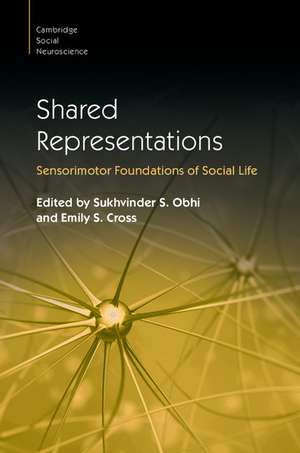Shared Representations: Sensorimotor Foundations of Social Life: Cambridge Social Neuroscience
Editat de Sukhvinder S. Obhi, Emily S. Crossen Limba Engleză Hardback – 16 noi 2016
Preț: 869.42 lei
Preț vechi: 1010.95 lei
-14% Nou
Puncte Express: 1304
Preț estimativ în valută:
166.36€ • 173.69$ • 137.69£
166.36€ • 173.69$ • 137.69£
Carte tipărită la comandă
Livrare economică 05-19 aprilie
Preluare comenzi: 021 569.72.76
Specificații
ISBN-13: 9781107050204
ISBN-10: 1107050200
Pagini: 712
Ilustrații: 72 b/w illus. 37 colour illus. 3 tables
Dimensiuni: 157 x 236 x 36 mm
Greutate: 1.23 kg
Editura: Cambridge University Press
Colecția Cambridge University Press
Seria Cambridge Social Neuroscience
Locul publicării:New York, United States
ISBN-10: 1107050200
Pagini: 712
Ilustrații: 72 b/w illus. 37 colour illus. 3 tables
Dimensiuni: 157 x 236 x 36 mm
Greutate: 1.23 kg
Editura: Cambridge University Press
Colecția Cambridge University Press
Seria Cambridge Social Neuroscience
Locul publicării:New York, United States
Cuprins
Part I. Foundations: 1. What it takes to share a task: sharing versus shaping task representations Thomas Dolk and Wolfgang Prinz; 2. Merged minds: integration of bottom-up and top-down processes for social interactions Krista Grigaityte and Marco Iacoboni; 3. A new view of the motor cortex and its relation to social behaviour Michael S. A. Graziano; 4. Beyond action: shared representations in non-motor domains Michel-Pierre Coll and Philip L. Jackson; 5. Cognisance of the neuroimaging methods for studying the social brain Stephanie Cacioppo and John T. Cacioppo; Part II. Imitation and Mimicry: 6. The comparative study of imitation mechanisms in non-human primates Francys Subiaul, Elizabeth Renner and Edward Krajkowksi; 7. The cultural transmission of social information Janine Oostenbroek and Harriet Over; 8. The control of shared representations and social cognition Lara Bardi and Marcel Brass; 9. Neurocognitive explorations of social mimicry Sukhvinder S. Obhi; Part III. Thinking, Perceiving and Acting with Others: 10. Levels of complexity and the duality of gaze: how social attention changes from lab to life K. E. W. Laidlaw, E. F. Risko and A. Kingstone; 11. Acting together: representations and coordination processes Cordula Vesper and Natalie Sebanz; 12. Joint perception Jorina H. von Zimmermann and Daniel C. Richardson; 13. Social antecedents and consequences of behavioural synchrony Daniël Lakens, Thomas Schubert and Maria-Paola Paladino; 14. Musical ensemble performance: representing self, other, and joint action outcomes Peter E. Keller, Giacomo Novembre and Janeen Loehr; Part IV. Understanding Others: 15. The social function of the human mirror system: a motor chauvinist view Antonia Hamilton; 16. Biological tuning of mirror mechanisms: evidence and functional implications Clare Press; 17. Representation of self vs others' actions John A. Dewey and Günther Knoblich; 18. Reading intention in action Caterina Ansuini, Andrea Cavallo, Cesare Bertone and Christina Becchio; 19. Complementary actions Luisa Sartori; 20. Emotional convergence: a case of contagion? Guillaume Dezacache, Terry Eskenazi and Julie Grèzes; Part V. Learning and Development: 21. Shared interoceptive representations: the case of alexithymia Rebecca Brewer, Richard Cook and Geoffrey Bird; 22. Mirror neuron formation via associative learning Caroline Catmur; 23. Disorders of shared representations Jennifer Cook; 24. Learning by diffusion: using diffusion experiments and social network analysis to understand the dynamics of cultural evolution Cameron R. Turner and Emma Flynn; 25. Observational motor learning Heather McGregor and Paul L. Gribble; 26. The impact of action expertise on shared representations Emily S. Cross and Beatriz Calvo-Merino; Part VI. Shared Representations in Applied Contexts: 27. Sport performance: motor expertise and observational learning in sport Cosimo Urgesi and Stergios Makris; 28. Shared mental models in sport and refereeing Dave Collins and Andy Hill; 29. Musical synchronisation, social interaction, and the brain Kristina Waclawik, Sarah Watson and Jessica A. Grahn; 30. You move, I watch, it matters: aesthetic communication in dance Guido Orgs, Dana Caspersen and Patrick Haggard.
Recenzii
'If you are to have one book on social cognitive neuroscience, this is it. The contributors have all made major contributions to the study of social cognition and here present, in a most engaging style, the latest work concerning the nature of shared representations. This book represents the most fruitful approach to the topic currently available.' Chris Frith, University College London
'Understanding how the brains of two persons in interaction influence each other and represent the world around them is a thrilling challenge that neuroscience is currently tackling. This book will tell you everything you need to know about this topic, from the neural representation of simple motor actions to the human ability to learn by observing others.' Gayannee Kedia, University of Graz, Austria
'Understanding how the brains of two persons in interaction influence each other and represent the world around them is a thrilling challenge that neuroscience is currently tackling. This book will tell you everything you need to know about this topic, from the neural representation of simple motor actions to the human ability to learn by observing others.' Gayannee Kedia, University of Graz, Austria
Descriere
A collection of cutting-edge contributions on the idea of shared representations - information sharing between the brains of those involved.
